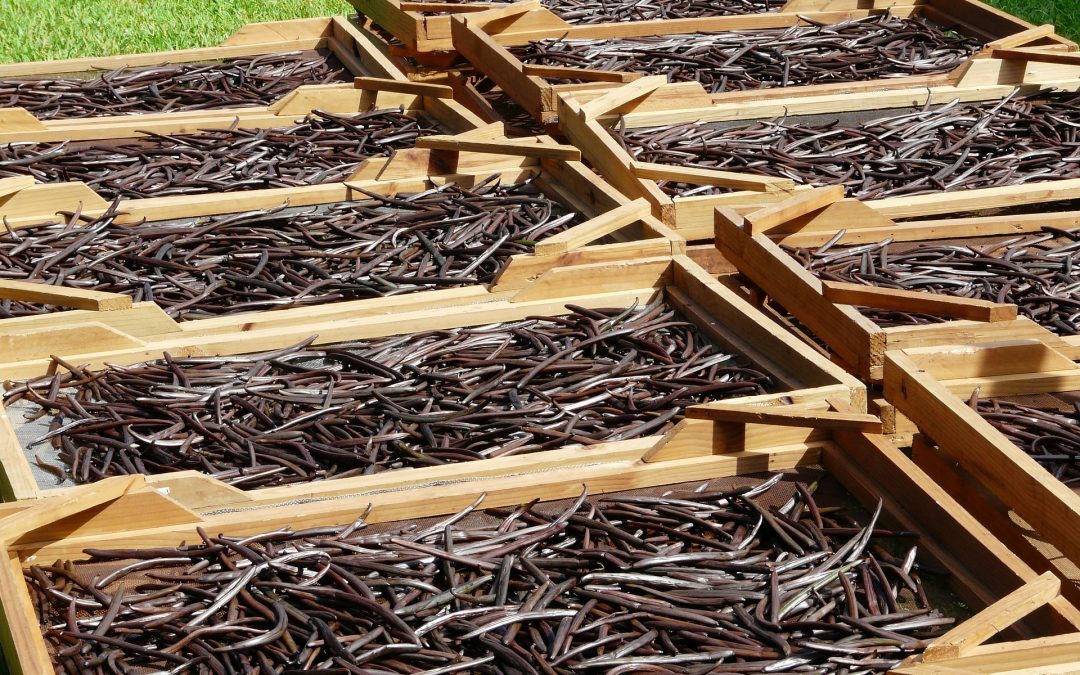The word “vanilla” has come to mean a bit dull over recent years. At Dexter & Mason, we think this is rather unfair, as vanilla has long been one of our favourite scents. It also comes with quite a history, and is one of the most impressively fussy crops to cultivate. Here’s a bit more about the lovely “little pod”.
It’s really tricky to produce…
Vanilla comes from the pod of an orchid, and will only grow close to the Equator. Unbelievably for such a commonly used flavour and fragrance, vanilla is the second-most expensive spice (saffron wins). This is because it’s so labour-intensive to produce and harvest. It may literally grow on trees (naturally, uncultivated vanilla vines will wrap around trunks), but that doesn’t make it easy. Cultivated vanilla flowers have to be hand-pollinated, and if that wasn’t tricky enough, the flowers bloom for only a day. Vanilla farmers have to keep a close eye on their plants, and dive in with their pollination sticks as soon as the blooms appear.
…really tricky
It’s a long and involved business, growing vanilla. The vines are mature in about three years, then it’s time to look out for those blossoming blooms. The hand-pollinated plants produce fruit in the form of the distinctive vanilla pod. The pods are hand-harvested, and at this stage, they have no scent or flavour – that comes with processing. The pods are sorted then boiled, then begin their lengthy curing process. They’re dried in the sun then conditioned in wooden boxes, which takes several months. The good news is that a healthy vine should last about 15 years, and produce 50-100 beans a year.
The legend of vanilla
The first people to cultivate vanilla were the Totonecs of Mexico. In Totonec legend, vanilla was first formed when the blood of runaway lovers was spilled on the forest floor. However, this bloody story didn’t put them off, and the Totanecs were the main producers of vanilla in the world until the mid-19th century. When they were conquered by the Aztecs in the 14th century, they had to pay their new rulers tribute in vanilla beans. And of course, a few generations later, the Spanish learned about vanilla from the Aztecs.
Vanilla in Europe
Like chocolate, vanilla came to Europe with the Spanish in the early 16th century. Initially, it was combined with chocolate to make a delicious drink, before becoming popular as a flavour in its own right. European gardeners tried to cultivate this delicious new product; however they soon found that while the vines grew, they didn’t flower. It turns out that there’s only one species of bee that can pollinate the vanilla orchid, and that’s native to Mexico. Eventually, Edmond Albius, a 12-year-old slave in Madagascar (where Bourbon vanilla is cultivated), developed a hand pollination technique using a stick.
Vanilla in perfume
With its distinctive sweet scent, vanilla grew in popularity as a fragrance as well as an ingredient. Its soft, warm tones are associated with comfort and the home. Think of winter Sunday baking and sweet-smelling puddings. It’s also great to enhance the sweetness of floral notes – we use it in our Cardamom & Mimosa candle. Vanilla also has long associations with sensuality, which has made it a popular base note for headier, grown-up perfumes and scented oils. Our sophisticated Black Pomegranate candle has a base of vanilla and amber for a really luxe feel.
Yes, vanilla is an aphrodisiac
With its heady scent and romantic legends, it’s not surprising that vanilla is thought of as a sexy scent. There’s actually science behind this, and a study in 2012 found that rats became more, er, romantic after being exposed to vanillin. The fragrance is believed to appeal to human males, too. According to smell expert Dr Alan Hirsch, because it creates feelings of happiness and security. It’s a positive memory trigger, and interestingly, is one of those scents that has global appeal.
Traditional healing properties
Because of these positive associations, vanilla can be used to calm and uplift – our customers often describe our vanilla-based products as “comforting”. Like many plants, vanilla also has a long history of medicinal uses. Vanilla essential oil is antibacterial, and is a traditional remedy to heal burns. Vanilla repels bitey insects, and the dried pods can be used to scare away spiders (disclaimer: we haven’t tried this one yet). Culinary vanilla may also have digestive properties. Finishing your meal with a scoop or two of vanilla ice cream can be justified as an essential aid to digestion, not simply a desire for pudding…
Vanilla is never, vanilla
From being the highest-maintenance crop to an age-old aphrodisiac, vanilla is most definitely not boring. We love its full-bodied fragrance, and it’s our go-to base note if we want a calm and comforting scent. Try our White Patchouli & Clove candle, and you’ll see what we mean.
If there’s a scent you really love, please get in touch with us at Dexter & Mason. We can help you find the perfect fragrance from our collection of scented candles and reed diffusers.


